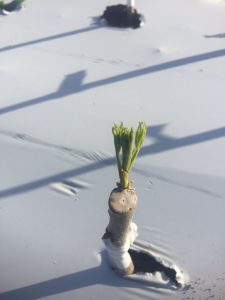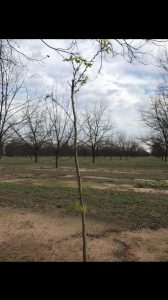 Nursery tree leafing out 2/21/2017
Nursery tree leafing out 2/21/2017
 Young pecan tree in orchard leafing out 2/21/2017
Young pecan tree in orchard leafing out 2/21/2017
We haven’t had much of a winter this year. We’ve only had 4 days where temperatures dipped below freezing in Tifton and the average temperature since November has been 57 degrees as opposed to 55 degrees last winter. We’ve also accumulated only 368 chill hours as opposed to the 559 chill hours we had by this time last year.
For many fruit trees, once buds have entered dormancy, they will be tolerant to temperatures below freezing and will not grow in response to mid-winter warm spells. These buds remain dormant until they have accumulated sufficient chilling units (CU) of cold weather. When enough chilling accumulates, the buds are ready to grow in response to warm temperatures. As long as there have been enough CUs the flower and leaf buds develop normally. If the buds do not receive sufficient chilling temperatures during winter to completely release dormancy, trees will develop various physiological symptoms associated with insufficient chilling.
Its really not clear how many chill hours pecans need, probably because there is so much variation from one variety to the next. It is reported that 300 -500 chill hours are required for Desirable, Mahan, Success, and Schley, while Stuart reportedly requires from 600-1000 (I think that’s a little high, myself). Interestingly, Terminal buds have lower chill requirements than lateral buds. So, after a cold winter you may have heavier crop loads because more lateral buds flower and get pollinated at the right time.
In general, pecans don’t need a lot of chill hours. At the southern end of its range in Mexico, you can have trees that receive less than 100 chill hours, which still produce nuts. The actual chilling requirement for pecans also varies with fall temperatures. If trees are exposed to cooler fall temps (less than 34 degrees F) the intensity of the bud’s rest is greater and the number of chill hours required for budbreak increases. But, the colder the winter, the fewer the heat units in spring required to start budbreak. Heat units in spring strongly influence budbreak and drive the progression of the crop’s maturity. So, with a cold winter and warm spring you can actually get a pretty early budbreak.
We had a warm fall, therefore the intensity of the bud’s rest is weak and the number of winter chill hours required for budbreak will be lower. Indeed if you look around at the edges of fields and in the woods you will see red maples, red buds, and oaks budding out. Azaleas are blooming in the yards. And yes, some pecans are even budding out already as you can see from the pictures above. Unless we have a cool spell to slow things down I expect to see a lot of buds breaking within 2 weeks. What will this mean for the crop?
Well, the main thing is we have to hope and pray for a warm spring with no late freeze. Any late freeze down into the 20’s for any significant length of time after the shoots begin expanding, putting on catkins and female flowers will cause serious problems. The tissue would be burnt off by the freeze. The trees would shoot back out, and grow. We would lose that flower crop and some varieties would try to put on more flowers but most of those secondary flowers either wouldn’t develop into nuts or the nuts would be of very poor quality (because pollination would be off).
Beyond a late freeze, the most likely problem will be poor pollination. Because budbreak tends to be so sporadic, staggered, and non-uniform when you have low chill hours, the synchronization of female flowers with male flowers from the pollinators is usually off, leading to poor nut set and poor quality. The more cold snaps we have from here on out, the more non-uniform budbreak and flower development will be. So, from this point on we need it to stay warm.
